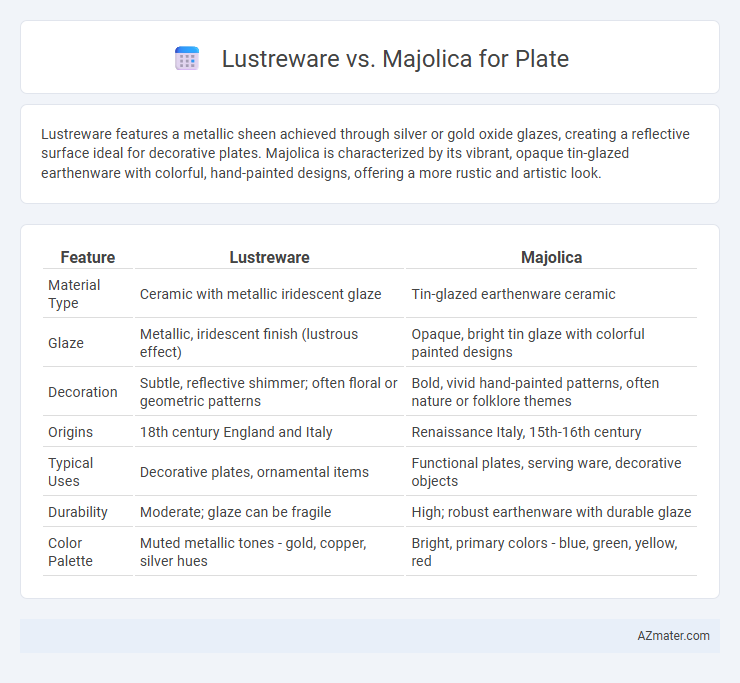Lustreware features a metallic sheen achieved through silver or gold oxide glazes, creating a reflective surface ideal for decorative plates. Majolica is characterized by its vibrant, opaque tin-glazed earthenware with colorful, hand-painted designs, offering a more rustic and artistic look.
Table of Comparison
| Feature | Lustreware | Majolica |
|---|---|---|
| Material Type | Ceramic with metallic iridescent glaze | Tin-glazed earthenware ceramic |
| Glaze | Metallic, iridescent finish (lustrous effect) | Opaque, bright tin glaze with colorful painted designs |
| Decoration | Subtle, reflective shimmer; often floral or geometric patterns | Bold, vivid hand-painted patterns, often nature or folklore themes |
| Origins | 18th century England and Italy | Renaissance Italy, 15th-16th century |
| Typical Uses | Decorative plates, ornamental items | Functional plates, serving ware, decorative objects |
| Durability | Moderate; glaze can be fragile | High; robust earthenware with durable glaze |
| Color Palette | Muted metallic tones - gold, copper, silver hues | Bright, primary colors - blue, green, yellow, red |
Introduction to Lustreware and Majolica Plates
Lustreware plates feature a distinctive metallic sheen achieved through a metallic glaze containing precious metals like gold, silver, or copper, reflecting light with an iridescent finish. Majolica plates are known for their vibrant tin-glazed earthenware, often adorned with intricate, colorful hand-painted patterns and motifs inspired by nature, mythology, or historic themes. Both Lustreware and Majolica plates are prized for their decorative beauty and craftsmanship, with Lustreware emphasizing metallic luster and Majolica showcasing vivid, opaque glazes.
Historical Origins of Lustreware and Majolica
Lustreware originated in the Middle East during the 9th century, characterized by its iridescent metallic glaze achieved through a complex firing process involving metallic oxides. Majolica, emerging in the Italian Renaissance around the 15th century, features tin-glazed pottery with vibrant, colorful designs painted over an opaque white surface. Both techniques reflect distinct cultural and technological advancements: Lustreware's influence spread across Islamic and European ceramics, while Majolica became a hallmark of Italian decorative artistry.
Distinctive Artistic Techniques
Lustreware plates showcase a distinctive iridescent metallic glaze achieved through multiple firings and the application of metal oxides like silver or copper, creating a shimmering surface that changes color in different lights. Majolica plates are characterized by their vibrant, opaque tin-glazed earthenware with hand-painted motifs often depicting natural scenes, enhanced by the glossy, white glaze that serves as a canvas for intricate designs. The key artistic difference lies in Lustreware's reflective, metallic sheen versus Majolica's colorful, opaque tin glaze that highlights detailed brushwork.
Materials and Glazing Processes
Lustreware plates are characterized by a metallic glaze achieved through a complex firing process that involves applying a thin layer of metallic oxides, creating an iridescent sheen on the surface. Majolica plates, in contrast, feature a tin-glazed earthenware base that provides a bright white, opaque canvas, ideal for vibrant hand-painted designs. The glazing process for Majolica uses a lead-based tin glaze fired at a lower temperature, which contrasts with the more intricate multi-stage firings required for Lustreware to develop its distinctive reflective quality.
Color Palettes and Surface Finishes
Lustreware plates feature iridescent, metallic glazes with shimmering color palettes ranging from golds and silvers to vibrant blues and purples, creating a reflective surface finish that adds depth and elegance. Majolica plates showcase bright, opaque glazes with vivid colors such as emerald greens, cobalt blues, and sunny yellows, offering a textured, glossy surface often enhanced by hand-painted designs. The distinction in surface finishes between Lunsterware's glossy, mirror-like quality and Majolica's thick, vibrant enamel highlights their unique aesthetic appeal for decorative and functional tableware.
Durability and Practical Use
Lustreware plates feature a metallic glaze that is visually striking but more prone to chipping and wear due to its delicate iridescent finish. Majolica, characterized by its thick, colorful tin-glazed earthenware, offers greater durability and resistance to everyday use, making it more practical for frequent dining. When choosing between the two, majolica plates withstand regular handling and washing better, while lustreware is best reserved for decorative or occasional use to preserve its finish.
Collectibility and Market Value
Lustreware plates, renowned for their iridescent glaze and intricate patterns, often command higher collectibility due to their unique shimmering finish and limited production. Majolica plates, distinguished by vibrant, earthy glazes and naturalistic designs, maintain steady market value owing to their historic popularity and diverse styles. Collectors typically favor Lustreware for its rarity and visual appeal, while Majolica appeals to those interested in rustic charm and extensive variation.
Popular Patterns and Motifs
Lustreware plates frequently showcase iridescent glazes with intricate floral patterns and peacock feather motifs, popular in 19th-century English and Italian ceramics. Majolica plates are known for their vibrant, hand-painted scenes featuring animals, fruits, and Renaissance-inspired foliage, reflecting Mediterranean artistic traditions. Both styles emphasize bold, decorative designs, but Lustreware leans toward metallic sheens while Majolica highlights bright, opaque colors.
Care and Maintenance
Lustreware plates require gentle hand washing with mild detergents to preserve their metallic sheen and prevent chipping, while avoiding abrasive scrubbers that can damage the finish. Majolica plates, known for their vibrant, lead-glazed surfaces, also benefit from hand washing but can tolerate slightly more robust cleaning due to their thicker glaze. Both types should be stored carefully to prevent scratches and avoid exposure to extreme temperatures that can cause cracking or crazing.
Choosing Between Lustreware and Majolica Plates
Choosing between Lustreware and Majolica plates depends on desired aesthetics and durability; Lustreware features a metallic, iridescent glaze with vibrant, reflective colors, while Majolica is known for its opaque, brightly colored tin-glazed earthenware with intricate, hand-painted designs. Lustreware plates are often more delicate due to their thin glaze, making them better suited for decorative use, whereas Majolica plates provide a sturdier option for everyday dining with their robust, thick ceramic body. Collectors and designers prioritize Lustreware for its unique shimmer and Majolica for its traditional, rustic appeal and heavier craftsmanship.

Infographic: Lustreware vs Majolica for Plate
 azmater.com
azmater.com